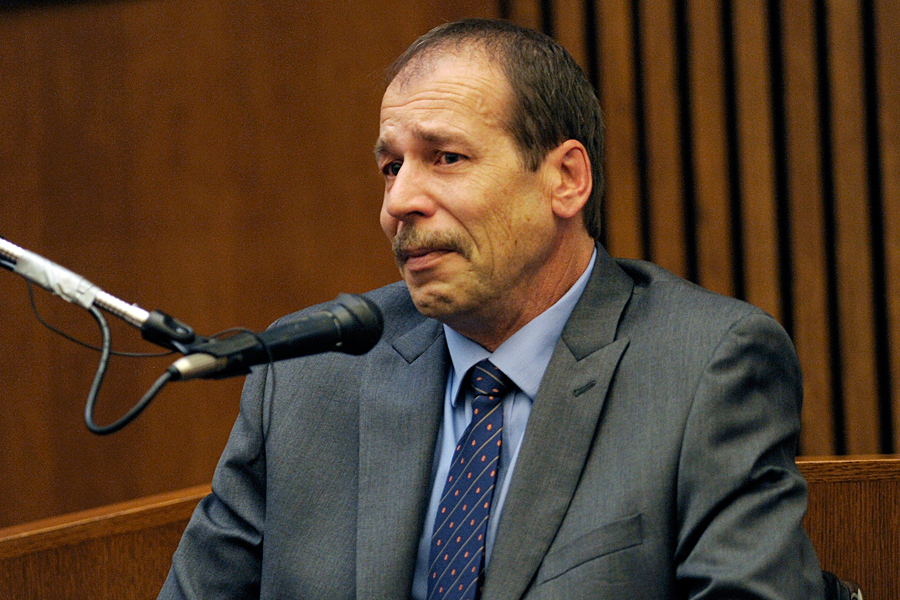Renisha McBride porch shooting goes to jury: Does paranoia limit self-defense?
Loading...
| Atlanta
A Detroit jury now has the Renisha McBride porch shooting case, a post-Trayvon Martin case widely seen as testing whether paranoia over crime and liberalized gun laws impose any limits on self-defense arguments.
Detroit homeowner Theodore Wafer faces second-degree murder charges for the Nov. 2 shooting death of Ms. McBride, an unarmed black teenager who was seeking help after a drunk-driving accident when Mr. Wafer, who is white, fired at her from behind a screen door, killing her.
In 10 days of trial, the jury has heard prosecutors describe the middle-aged Mr. Wafer as a reckless gun owner who treated a deadly weapon “like a toy” and who lied to police, first saying the shooting was an accident and then saying he shot in self-defense. Wafer’s defense has painted him as a beleaguered homeowner in a crime-ridden city who feared for his life as McBride “pounded” on the door at 4:40 in the morning.
Before the prosecution and defense made their final arguments Wednesday, Wafer spent two days on the stand, describing how he suddenly found himself under a mysterious siege in his own home.
“I thought they were going to come through.... I didn’t want to cower. I didn’t want to be a victim in my own house,” he told jurors. Prosecutors said he should’ve stayed inside his home and called 911.
Reminiscent of the Trayvon Martin shooting and subsequent trial of George Zimmerman, the case is at its core a self-defense trial with racial overtones: In a city in which 80 percent of residents are black, McBride was unarmed and black and Wafer was armed and white.
The jury, which includes four African-Americans, will have to decide whether, under Michigan self-defense law, Wafer “honestly and reasonably” believed he was in such danger that he had to make use of his Mossberg 12-gauge shotgun. Michigan law says a homeowner has no obligation to retreat from danger before using deadly force in self-defense.
The porch shooting has for some become emblematic of rising paranoia over race and crime in a bankrupt city seen as a focal point for America’s economic and social struggles. The shooting also focuses attention, again, on the impact of the steady liberalization of gun laws that protect gun owners who use their weapons for self-defense both in their homes – the castle doctrine – and in public, i.e. “stand your ground.”
Detroit’s budget crisis has led to cutbacks in law enforcement, and a subsequent arming of Detroit residents. The city had 40 justifiable homicides in 2012 and 2013, and has seen eight this year – by far the highest rates of any metro area in America.
Detroit Police Chief James Craig has actively encouraged city residents to take up arms. One of Chief Craig’s sergeants, Michael Woody, told Detroit news media after a justified shooting in March that “Detroiters have had it,” noting that Chief Craig “has often said good Americans that are legally in possession of firearms are defending their homes, and they have the right to do that, and we stand behind them in doing so.”
Detroit history also contains an apocryphal gun rights story in which a black man, Dr. Ossian Sweet, in the 1920s shot into a mob of white people about to attack his house; Sweet was acquitted after a jury found he acted in reasonable self-defense.
While the racial dynamics of the Renisha McBride porch shooting case have chafed many in Detroit, the trial itself hasn’t touched on race. Wafer testified that he fired at a figure, but that he couldn’t tell “what gender, what origin, what race” McBride was.
“I don’t know why this was brought to me,” Wafer said Tuesday of the shooting. “I didn’t go out looking for this.”
Prosecutors, meanwhile, made it clear that the loud assault on his house angered Wafer to a point where his actions became unreasonable. His contention that he couldn’t find his cell phone to call 911 also drew particular skepticism from prosecutors.
Wafer left out critical details in early interviews with police, prosecutors said, including that he at one point grabbed a baseball bat before exchanging it for the shotgun, which he said he had kept loaded after an earlier incident in which neighborhood kids fired paintball guns at homes.
In other high-profile self-defense cases, juries have struggled to define whether shootings are reasonable. In 2013, a Sanford, Fla., jury acquitted Mr. Zimmerman, who acknowledged shooting Trayvon, an unarmed black teenager.
Another Florida court is readying for a September re-trial of Michael Dunn, a white man who killed an unarmed black teenager in November 2012 after an argument over loud rap music outside a convenience store.
Earlier this year, a jury that heard self-defense arguments found Dunn guilty of attempted murder for shooting at a car full of teenagers, but deadlocked on a key murder charge.








